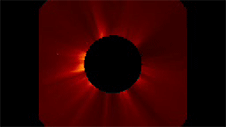Two main types of explosions occur on the sun: solar flares and coronal mass ejections. Unlike the energy and x-rays produced in a solar flare – which can reach Earth at the speed of light in eight minutes – coronal mass ejections are giant clouds of solar material that take one to three days to reach Earth. Once at Earth, these ejections, also called CMEs, can impact satellites in space or interfere with radio communications. During CME Week from Sept. 22 to 26, 2014, we explore different aspects of these giant eruptions that surge out from the star we live with.
Those who study Earth’s weather have a luxury of data points to study. From thousands of weather stations measuring temperature and rainfall to satellites tracking storm fronts up in space, meteorologists can watch detailed maps of the weather as it sweeps across land or sea.
Compared to this, the study of space weather – including CMEs – is a much younger science, with far fewer observatories available. However, our resources have grown dramatically in the last decade: NASA currently flies 18 missions to study the sun’s effects at Earth and on the entire solar system, a field known as heliophysics, and additionally launches numerous short-flight rockets for observations of solar impacts in and above Earth’s atmosphere. Coupled with improved computer modeling, keeping an eye on – and getting a better understanding of – CMEs has taken a giant leap forward in the 21st century.
“Over the past ten years, we have had a major breakthrough in understanding space weather,” said Antti Pulkkinen a space weather scientist at NASA’s Goddard Space Flight Center in Greenbelt, Maryland. “We can now track the basic properties of CMEs. When our solar observatories see a CME, we can tell what direction it’s going in and how fast it’s traveling.”
Improved observations combined with improved models has led to hybrid descriptions of a CME, relying partially on computer simulations and partially on actual observations. NASA houses a collection of space weather models available for public access at the Community Coordinated Modeling Center at Goddard. Together with observations they can provide a holistic picture of any given CME.
For example, NASA’s Solar and Terrestrial Relations Observatory, or STEREO, might see a CME erupt on the sun. When that imagery is combined with observations from the European Space Agency and NASA’s Solar and Heliospheric Observatory, or SOHO, scientists can create a 3-dimensional picture of the giant cloud. Scientists then input this data into a model and then track how the CME unfolded and spread through space until it passed by NASA observatories closer to Earth. These observatories can directly measure the magnetic fields and speed of the CME as it passes by, as well as see how it affected Earth’s own magnetic fields – the magnetosphere.
Such information on the CME’s entire path opens the door to understanding why any given characteristic of the CME near the sun might lead to a given effect near Earth. Each additional piece of the puzzle helps us better understand just what causes these giant eruptions — and whether or not any particular CME could pose a hazard to astronauts as well as technology in space and on the ground.
Related Links
› More on CME Week
› More on STEREO
› More on SOHO
› Other NASA Sun-Earth missions
Karen C. Fox
NASA’s Goddard Space Flight Center, Greenbelt, Md.























